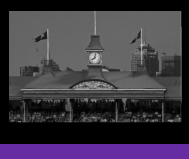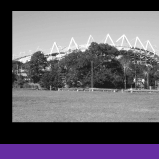 |

Issues
Liability | Governance | Health and Safety | Planning |The Problem | The Solution
Public Health and Safety
"Fox Studios is a tight concentration of many
hazardous processes in a small area.
Developments for “craft shops”
acknowledge that industrial processes are
being carried out in factory-type workshops and would ordinarily be considered a heavy
industrial site (4b zoning)." (see glossary)
From Professor Chris Winders' presentation to Public Meeting (17th August 2006)
This statement, made by Professor Chris Winder, forms the basis of our criticism of the actions taken by Federal, State and Local government regarding the former RAS Showgrounds.
The main focus of the health and safety problems at FSA relate to the use and storage of industriral chemicals, the management of asbestos materials, and fire safety. Activities that are usually considered to be incompatible with high or medium density residential areas, such as spray painting, fibre glass construction, pyrotechnics, MDF, and welding are routinely undertaken on the FSA site within 15 - 30 metres of homes, schools, places of public interest, and sporting grounds (NECS February 2005 p.2)
The Federal Government's National Industrial Chemicals Notification and Assessment Scheme (NICNAS) provides the following definition of 'industrial chemicals':
"Under the Industrial Chemicals (Notification and Assessment) Act (1989) (the Act), an 'industrial' chemical is any chemical that has an industrial use. This includes specialty chemicals, dyes, solvents, adhesives, plastics, laboratory chemicals, chemicals used in mineral and petroleum processing, refrigeration, printing and photocopying, paints and coatings, as well as chemicals used in the home, such as cleaning products, cosmetics and toiletries."
Under this definition, the Fox Studios Australia site is one that operates using industrial chemicals, and while this definition indicates that a number of 'industrial chemicals' are also used in the home, the volume of chemicals used on the Fox Studios Australia site is much larger. For instance, your home is unlikely to require a licence from the Environmental Protection Authority, whereas the FSA has frequently required this kind of licence.
This website argues that to answer is built upon Implementations, Compliance and Enforcement of these recommendations.
Recommendations:
Spray painting booths in building 34 (4) and 36 (1), but also in buildings 48(1) and Sound Stage 1. |
|
Thinners and solvents which contain Volatile Organic Compounds (VOCs) are the main area of concern. These are commonly used in motor vehicle industry which provides a useful reference point for the kind of protections that should be in place. Appropriate levels of monitoring and compliance for motor vehicle industry is also good indicator how this might be organised at the Fox Studios Site.
Australian Standards
- Australian Standard AS/NZS 4114.1 Spray Painting Booths Part 1Design,
Construction and Testing
- Australian Standards AS/NZS 2381.1 Electrical equipment for
explosive atmospheres – Selection, installation and maintenance – General requirements
- AS 1482
Electrical Equipment for explosive atmospheres – Protection by ventilation
Work Cover
"Some common hazardous substances in the MVRI include
degreasers, petroleum products, cleaning agents, two pak and other paint products and asbestos in
brake or gasket linings. Hazardous substances can enter the worker through ingestion, absorption or
inhalation and often have a latency effect on the health of exposed workers sometimes over 20–30
years after exposure."
See more on motor vehicle repair industry hazards>>
"Large amounts of solvents are used in industry. They are often used as cleaners or degreasers and as an ingredient in paints, inks, glues, and varnishes. Many of these products have more than one solvent in them."
See more on solvents >>
See more on spray painting >>
OHS Regulation 2001
"Employers are required to ensure a safe workplace and in particular to comply with requirements for
spray painting in Part 7.1: Spray Painting of the OHS Regulation 2001. Other relevant parts of the
Regulation are Chapter 2: Places of Work – risk management and other matters, Part 5.4: Working
with Plant and Part 6.4: Use of Hazardous Substances."
See more>>
Hazardous Substances - under EPA and POEO Acts
Environmental Protection Licence A -
"Under the POEO Act, the Environment Protection Authority (EPA) is the appropriate regulatory
authority for all scheduled activities and scheduled development work. The EPA is also the regulatory
authority for non-scheduled activities where they are subject to a licence, or are carried on by the
State or a public authority. Most other non-scheduled activities are regulated by what the POEO Act
calls ‘local authorities’. In nearly all cases local authorities are local councils."
"In general the EPA will not issue a non-scheduled activity licence where there is a low likelihood of
impact on waters and where pollution should not occur if the activity is carried out in strict compliance
with a best-practice guideline."
See more >>
Fire Issues
"Most solvents are flammable. Some chlorinated hydrocarbon solvents are non-flammable. However, if they are exposed to flames or hot metal surfaces they can give off a toxic gas called phosgene."
See more >>
EPA Assessment and Management
of Odour from Stationary
Sources In NSW
"The policy
adopts the Victoria EPA ground level concentration criteria. These criteria are based on odour
threshold or toxicity threshold (whichever is more stringent) and should not be exceeded at any
location beyond the boundary of a facility."
p3 see policy >>
|
|
|
|
Fibreglass moulding and destruction
Other national experiences and note that Australia is out of step. |
|
Resins and and catalysts used to stiffen the glass fibres into forms such as boat hulls, or sets. MEKP solvents and thinners are the main area of concern. Respiratory issues may also arise from inappropriate destruction of fibre-glass moulds containing polyester resins.
Australian Standards -Mask types and fume cupboards, p
Work Cover NSW - (non-statutory enforcements).
Hazardous Substances - Schedule A under EPA and POEO Acts
Fire Issues - thinners and solvents but also dust.
EPA Assessment and Management
of Odour from Stationary
Sources In NSW (January 2001)
The policy
adopts the Victoria EPA ground level concentration criteria. These criteria are based on odour
threshold or toxicity threshold (whichever is more stringent) and should not be exceeded at any
location beyond the boundary of a facility.
p3 see policy >> |
| |
|
|
MDF Construction
Other national experiences and note that Australia is out of step.
Formaldehyde and Particulates - silicosis |
|
A disease-creating material - formaldehyde and particulates (dust) being the main area of concern. Particulates may be absorbed into bloodstream through inhalation, ingestion or through the surface of the skin (if sufficiently fine).
Australian Standards - there is no australian standard other than that applied to masks which should be used by those working with MDF.
Work Cover - POW SW procedures also apply (non-statutory enforcements).
Hazardous Substances - Schedule A under EPA and POEO Acts
Fire Issues - thinners and solvents but also dust. |
| |
|
|
Dyeing
Other national experiences and note that Australia is out of step. |
|
sodium hydrosulphide - pre-dyeing (see MSDS) pigments can be absorbed through skin ( ) Mordants (fixatives) are also problematic. OHS solvents.
Australian Standards - (Australian Standards x number)
Work Cover - POW SW procedures also apply (non-statutory enforcements).
Hazardous Substances - Schedule A under EPA and POEO Acts
Fire Issues - |
| |
|
|
Film processing
Formaldehyde |
|
solvents and thinners again - OHS would apply.
Australian Standards - (Australian Standards x number)
Work Cover - POW SW procedures also apply (non-statutory enforcements).
Hazardous Substances - Schedule A under EPA and POEO Acts
Fire Issues - thinners and solvents. |
| |
|
|
Welding
|
|
OHS (Toluene) and Phosgene Gas from ARC welding, Oxy and Gas Welding Mig, Tig Welding. Reference point here is World Towers example of welding (metal cutting)
Australian Standards - (Australian Standards x number)
Work Cover - POW SW procedures also apply (non-statutory enforcements).
Hazardous Substances - Schedule A under EPA and POEO Acts
Fire Issues - thinners and solvents but also dust. |
| |
|
|
| Chemical Storage |
|
Australian Standards
- Australian Standard AS/NZS 2243.10:2004 for chemical storage cabinets.
|
Case to answer is built upon Implementations, Compliance and Enforcement of these recommendations.
Implementation - have these recommendations been applied to premises and operation of FSA?
- Holmes Air Sciences Reports
DA for building 34 indicates that building 36 is used as a model for operations in the new building.
"The craftshop booth is fitted with paper filters, and while these are effective in absorbing aerosolised sticky material generated during spraying, the odour measurements made with and without the filters in place indicated that they are not very effective in reducing the volatile components of the emissions and hence the odour....additional odour controls are likely to be required."
(p4, introduction to Air Quality Impact Assessment, Building 34, Fox Studios Australia October 2004)
- Noel Childs Report
Review of Holmes Air Science Report conducted by Childs & Associates in 2004:
"On the basis of my consideration of the various documents provided, and the comments presented above, I have formed the conclusion that the information currently available regarding the use of volatile chemicals within the craft shop complex is incomplete." p4 Childs & Associates Review, May 2004
"The September 2003 assessment report by Holmes Air Sciences discusses at some length the limitations and subjectivity associated with the assessment and management of odour. The report also points in the variability in the response between individuals. This would appear to leave open the very real possibility that individuals in the community with a genuinely heightened sensitivity to the effect of chemicals and chemical odours might not be afforded adequate protection by measures appropriate for the general population. The further development of this matter would require input from appropriately qualified professionals." p3 Childs & Associates Review, May 2004
- NECS Report
- Douglas Partners
Compliance - have these recommendations been applied consistently across activity areas
Risk Management Guidelines (FSA)
17th March 2005 - Julian Thompson - EPA stated in phone conversation with JWE that the only method used to confirm that FSA has complied with EPA licence terms is through a verbal confirmation by FSA that they have done so.
GAP analysis - have these recommendations been applied consistently across activity areas ie panel beaters and ship builders?
- Holmes Air Sciences Reports
Kevin Winter notes that there are No North-North-East wind effects modelled for air quality (KW notes) therefore no modelling for SCG, Aussie Stadium or Bent St [Entertainment Quarter?]. See sensitive receptors requirments in EPA Odour assessment - would be a contravention?
SEE - Holmes Air Science Report on Spray Painting Booths 2002 (uses Goat Island for meteorological reference point)
- Noel Childs Report
Review of Holmes Air Science Report in 2004 indicates that while the technical specifications for undertaking air quality impact assessment have been met, they have not been sufficiently broad.
"I am not confident on the basis of the information available to me that the potential impacts of all the activities within the complex have been considered. In my opinion, this limits the level of confidence with which any conclusion on the matter can be accepted." p4 Childs & Associates Review, May 2004
- NECS Report
"Due to the need for facilities to meet the diverse requirements of production some activities can be undertaken in buildings not specifically managed for these activites."(p.1)
- Douglas Partners
- Niosh Order
Have special exemptions have been made for Fox?
Yes... The Serenity Cove sound stage complex was deemed inappropriate for a development such as that which has come to occupy the former Royal Agricultural Socity Showground site at Moore Park. This facility is zoned as x (Light Industrial) and cannot be co-located with residential or x activities.
Enforcement - criticisms of monitoring and evaluation?????
Statements from anyone as to the extent of monitoring and enforcement of terms.
- Holmes Air Sciences Reports
- Noel Childs Report
"On the basis of the material available to me, it apppears that if there was any consideration of air quality issues during the Development Application process, such consideration lead to the conclusion that the proposed craftshop project would involve no air quality issues of concern. Given the proximity of craftshop to residential receivers, and what appears to have been a lack of definition regarding the nature and extent of the activities and materials involved, a more rigorous approach might well have been more appropriate."
p3-4 May 2004
- NECS Report
- Douglas Partners
Q&A from hansard
All of this has been about words.....why do these standards apply to other businesses but not to FSA?
These questions are looked at in more detail in our discussions of planning, governance and insurance and compensation.
The timeline of events outlines the unfolding of the health and safety provides an extensive listing of incidents and correspondence regarding the activities of tenants and subtenants on the FSA site.
|
 |














